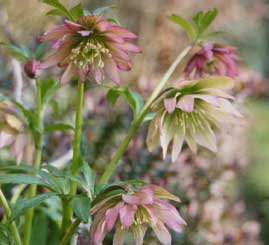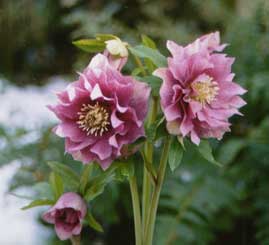


Dido double
German type double
As recently as the 90s, it was almost impossible to buy double hellebores. The odd picture would surface to tempt us, but only a few specialist nurseries were selling small numbers of plants, to those who knew where to look. The internet had not yet started to offer an easy way to track down rare plants.
The first doubles I saw 'in the flesh' were neatly laid out in rows on a table, in the way that only something special might be; it was a good way to take a close look, and to study the fascinating differences between them. They were curious, delicate and spiky little things, with an appearance that suggested anything more than the slightest breeze might pull them to pieces. Soon after, during a trip to Washfield Nursery, I was lucky enough to be shown a batch of doubles – tucked safely away from the main sales area, in a small greenhouse – that displayed a more robust constitution, and although I hadn't expected it, I came away from my visit suspecting I was hooked. In much the same way, half the people who visit my nursery today, claiming to not like doubles, become converts when they see them.
There are three main types of double (see below), but as the years have passed - and plants from each category have been crossed with each other - the situation has become less clear.
1. Double forms of H. torquatus. These have been developed from wild plants (naturally occurring doubles) originally collected by Elizabeth Strangman in Montenegro, the most well known of which is called Dido. They are small and dainty, and have foliage that's more finely divided than the other types. Leaves tend to be shed in autumn. During the 90s they were widely grown and promoted by Blackthorn Nursery (now closed).
2. Double forms of H x hybridus from Germany. These reached the UK in 1990, although they were extremely difficult to obtain for a number of years. The best known of these is called Gunther Jurgl, after the man that raised it. They tend to be quite short, vigorous and with larger blooms than the torquatus doubles. By today's standards, the outer petals have a fair degree of green on them, but they have proved invaluable in the development of new and better doubles.
3. Doubles derived from anemones. Soon after the first doubles appeared, growers began crossing them with singles to produce the first anemone centres. They, in turn, were crossed with each other or with existing doubles, and this has led to the development of colours and markings that might otherwise have been difficult or impossible to produce. Some of the resulting plants have proved to be outstanding, and the potential for further advancement continues.
Double hellebores are just as easy to grow in the garden as singles, but the torquatus types – just like their single-flowered cousins - can be less vigorous than the others and more susceptible to black spot. To stand a chance of producing double offspring, both parents need to be doubles or anemones, and this can be tricky in a garden situation where bees and other insects will be visiting plants on warm days. To increase the chance of doubles, plants can be kept in a separate area to the singles, or pollinated with a small paint brush, but the downside with both methods – even if they do produce the desired doubles – is that plants can end up being self-pollinated. This leads to weak plants and needs to be avoided if possible, but the only way of ensuring this is to carefully hand pollinate the two parents; understandably, the majority of people will not want to take things this far. For most, by increasing the chance of doubles, unwanted or weak offspring can easily be removed during their first flowering season.